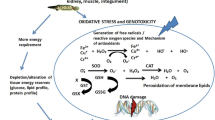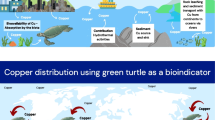Abstract
This study assessed the exposure and effects of trace elements in sentinel organisms, using the bivalve Crassostrea brasiliana in two estuarine areas in São Paulo State, Brazil: Santos Estuary and Cananéia Estuary, site of oyster farms, which was used as reference site. Oysters were evaluated for bioaccumulation of As, Co, Cr, Fe, Se and Zn by INAA and Cd, Pb and Hg by AAS. Effect biomarker was assessed by evaluation of lysosomal membrane stability. In the study of bioaccumulation of trace elements it was verified that Santos Channel presented the largest concentrations of elements studied in most cases. From the study of the cellular biomarker, it was verified that Santos Channel and winter showed higher stress to organisms in the present study.



Similar content being viewed by others
References
Lindeboom H (2002) The coastal zone: an ecosystem under pressure. In: Field JG, Hempel G, Summerhayes CP (eds) Oceans 2020: science, trends, and the challenge of sustainability. Island Press, Washington, pp 49–84
Neves R, Baretta J, Mateus M (2008) Perspectives on integrated coastal zone management in South America. IST Press, Portugal 604
National Institute of Standards and Technology, NIST (2001) Certificate of analysis. Standard Reference Material 1566b, Oyster Tissue, USA
MESL, IAEA Marine Environment Studies Laboratories (1998) Mineralization procedures for sediment and biological materials. Standard operating procedures, IAEA, Monaco
Lowe DM, Fossato VU, Depledge MH (1995) Contaminant—induced lysosomal membrane damage in blood cells of mussels Mytilus galloprovincialis from venice lagoon: an in vitro study. Mar Ecol Prog Ser 129:189–196
Bode P, Van Dijk CP (1997) Operational management of results in INAA utilizing a versatile system of control charts. J Radioanal Nucl Chem 215(1):87–94
Moreira EG, Vasconcellos MBA, Saiki M (2006) Uncertainty assessment in instrumental neutron activation analysis of biological materials. J Radioanal Nucl Chem 269:377–382
Moreira EG, Maihara VA, Catharino MGM, Vasconcellos MBA (2005) Report on NIST-CCHEN SIM 8.16P pilot study, elements in seafood
Kirschbaum AA (2010) Citogenotoxicidade e determinação de metais, PAHs e organoclorados em tecidos de Cathorops spixii e Centropomus parallelus provenientes de três complexos estuarinos da costa brasileira-Master Dissertation São Paulo University, São Paulo, p 268
CPTEC, Center for Weather Forecasting and Climate Research (2009) Accumulated precipitation – Brazil. http://clima1.cptec.inpe.br/siac/index.html. Accessed 10 Dec 2009
Miranda LB, Castro BM, Kjerfve B (1998) Circulation mixing due to tidal forcing in the Bertioga Channel, São Paulo. Brazil Estuaries 21(2):204–214
Brasil Ministério da Saúde. Secretaria de Vigilância Sanitária, Portaria n° 685, de 27 de agosto de 1998 fixa limites máximos de tolerância de contaminantes químicos em alimentos. Diário Oficial da República Federativa do Brasil, Brasília, 24 de setembro de 1998. Seção 1, parte 1, 1998, 1415
Brasil Leis, Decretos, etc., Decreto no 55871 de 26 de Março de 1965. Diário Oficial da República Federativa do Brasil, Brasília 09 de abril de 1965, Seção1, parte 1, 1965, 3611
Acknowledgments
The authors would like to acknowledge the financial support from CNPq from Brazil and IAEA from Vienna. To the Oceanographic Institute (IO) of the São Paulo University (USP) for the support in the collection of the samples.
Author information
Authors and Affiliations
Corresponding author
Rights and permissions
About this article
Cite this article
Catharino, M.G.M., Vasconcellos, M.B.A., Kirschbaum, A.A. et al. Passive biomonitoring study and effect biomarker in oysters Crassostrea brasiliana (Lamark, 1819: Mollusca, Bivalvia) in Santos and Cananéia Estuaries in São Paulo State, Brazil. J Radioanal Nucl Chem 303, 2297–2302 (2015). https://doi.org/10.1007/s10967-014-3720-y
Received:
Published:
Issue Date:
DOI: https://doi.org/10.1007/s10967-014-3720-y




